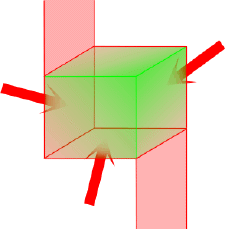The terms counting frame and counting brick are sometimes used synonymously. These terms originated from different sources and although similar, they are different in some important aspects. The confusion in the terms means that what is said or reported can be interpreted in different ways depending on who is reading or listening to a presentation. Further complicating the situation is the use of the hybrid term the “counting brick”.
The unbiased brick was published in 1985 by Howard, et al. The Optical Disector was published by Gundersen et al. in 1986. The unbiased brick method is the only of the two methods that can be mathematically proven unbiased (personal communication LM Cruz-Orive).
The unbiased brick derives its name from the fact that it is an extension of the 2-dimensional case in which tiling was used. The term brick refers to tiling in 3-dimensional space. The idea behind the brick is to tile all of 3-dimensional space with rectangular prisms that are all the same size. Particles being counted are assigned to the bricks in the 3-dimensional analog of the counting frame. The forbidden lines are extended into forbidden surfaces. The acceptance lines into acceptance surfaces.

Each brick has 3 surfaces that are acceptance surfaces and 5 surfaces that are rejection surfaces. There are the 2 surfaces that correspond to the tails of the counting frame. In addition, there are 3 surfaces, the left, the back, and the bottom surfaces all of which are pointed out by arrows in the drawing above. The single counting rule is: A particle is counted by this brick if it intersects the brick and does not intersect a rejection surface.
Therefore, if a particle is observed in the unbiased brick it is necessary to observe the particle throughout the brick to verify if the particle ever intersects any of the forbidden surfaces.
The unbiased brick requires that the observer focus up and down throughout the extent of the brick and verify that the particles being counted do not touch a forbidden surface and that some part of the particle does fall inside of the unbiased brick or touches an acceptance surface.
The Optical Disector uses a different method. The idea is based on the Disector. In the Disector, two sections are used. One section has a counting frame on it. A check is made to see whether the particle is selected by the counting frame. If it is selected, then a check is made to see if the particle is a top. It is top if the particle does not appear in the adjacent section referred to as the look-up section. The section with the counting frame is the reference section.
In the Optical Disector, the same kind of process is employed. Two sections are created optically. This is possible if the sections are thin enough. In a microscope, using a lens that has a thin focal plane creates the optical section. When the in focus plane is thin, the in focus image acts like a section. The observer focuses down through the slice. When a particle comes into focus the observer stops. Since the particle has not been into focus up to this point it means that the particle did not exist in the look-up section. The particle is compared to the counting frame. The counting frame rules are applied and a decision is made as to whether count the particle. If a particle is in focus at the top of the optical disector, then it is not counted. It is suppose that the particle exists in the look-up section and therefore is not a top. If the particle comes in to focus at the bottom of the optical disector, then the particle is not in the look-up section and therefore it is counted.
The unbiased brick and the Optical Disector do not count the same particles at the same time. Each technique is unbiased and does lead to an unbiased sampling of the particles based upon the existence of particles. Both the unbiased brick and the Optical Disector run into the issue of early vs. late recognition. Different observers decide at slightly different z positions that a particle has come into focus. Someone that decides early on that a particle is in focus is said to employ early recognition.
If early recognition is used at the top of an Optical Disector and late recognition is employed at the bottom, then an under projection of particles occurs. The opposite is true if late recognition is used at the top and early recognition is used at the bottom. The reason for this is that particles can be counted in more than one optical disector or not counted at all.
REFERENCES
Howard V, Reid S, Baddeley A, Boyde A., J Microsc 1985;138:203.
____________________________________________________________________

Sponsored by MBF Bioscience
developers of Stereo Investigator, the world’s most cited stereology system